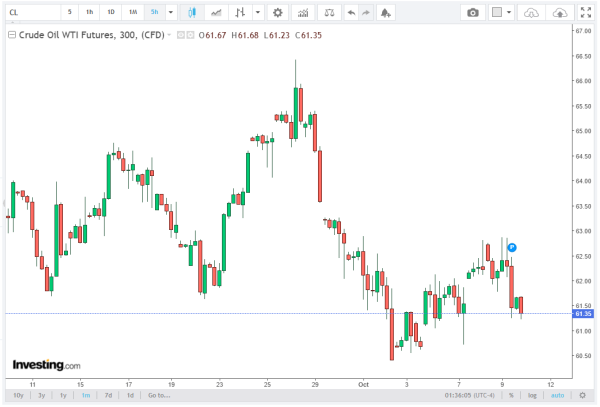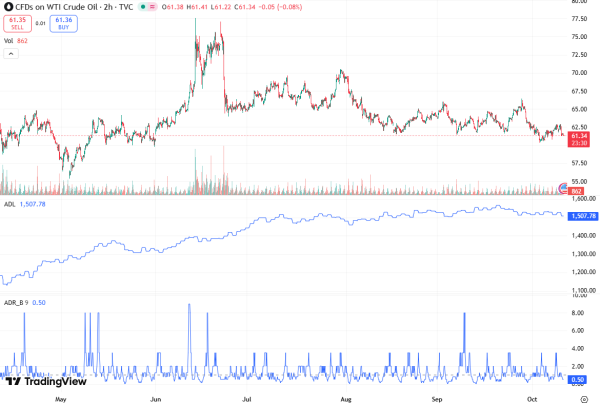West Texas Intermediate (WTI) US Crude Oil prices continued their downward drift for the second consecutive day on Friday, failing to recover from the mid-$62.00s highs reached earlier this week. The commodity remained pressured below the $61.00 mark, testing support near the weekly low touched on Tuesday.
The modest decline reflects a combination of technical vulnerability and broader macroeconomic concerns that are weighing on market sentiment. This article from Logirium offers readers a clear and informative explanation of the subject.
Geopolitical tensions, often a major driver for oil volatility, have recently eased. The US President confirmed that Israel and Hamas agreed on the first phase of his 20-point Gaza peace plan, following talks in Egypt. This announcement has alleviated fears of potential Middle East supply disruptions, one of the traditional catalysts for spikes in crude prices.
Simultaneously, market participants remain cautious about the impact of a potential US government shutdown, which could weaken economic activity and dampen crude demand in the world’s largest oil-consuming nation. The combination of these factors contributes to a cautious bearish bias in WTI price action.
Technical Analysis: Bears Maintain the Upper Hand
From a technical perspective, WTI has struggled repeatedly near the 200-period Exponential Moving Average (EMA) on the 4-hour chart, reinforcing the bearish setup. Multiple failed attempts to breach this key resistance indicate that sellers continue to dominate near the $62.00-$62.35 zone.
Additionally, negative momentum oscillators on both the 4-hour and daily charts suggest that the path of least resistance for crude is to the downside. Indicators such as the Relative Strength Index (RSI) and MACD have signaled declining bullish momentum, further supporting a bearish continuation scenario.
Immediate technical support is observed in the $60.25-$60.20 region, which coincides with the monthly low from May. A decisive break below $60.00, a psychological barrier, could trigger further selling pressure, prompting WTI to test lower levels near the $59.40 swing low before potentially reaching the $59.00 round figure.

Key Support Levels to Watch
Key support levels for WTI crude oil are critical to watch. The $60.25–$60.20 zone acted as near-term support in early May, while $60.00 is a psychological level that, if broken, could accelerate declines. The $59.40 May swing low serves as a key technical floor, and $59.00 is the likely final near-term support.
Failure to hold these levels would keep bears in control, increasing downside pressure. Traders should watch intraday price action closely, as breaks may trigger momentum-based selling.
Resistance Levels: Recovery Faces Hurdles
On the upside, any meaningful WTI recovery attempt is expected to face significant resistance near the $61.55-$61.60 range. A sustainable move above this area may enable crude to target $62.00, but bulls need to see a break and close above the 200-period EMA on the 4-hour chart, currently near $62.35, before attempting a move toward higher targets.
Until WTI convincingly clears these levels, the market is likely to remain in a range-bound or slightly bearish mode, with sellers having the technical advantage.

Fundamental Drivers: Supply, Demand, and Geopolitics
While technicals favor bears, WTI remains sensitive to fundamental developments. Any unexpected Middle East supply disruptions or US production adjustments could trigger sharp price reversals. Similarly, developments regarding the US government shutdown could impact oil demand forecasts, influencing near-term price action.
Global inventory data, including US crude stockpiles, often exerts additional pressure on WTI. An unexpected rise in inventories could reinforce the bearish bias, while a drawdown might temporarily support the commodity. Traders should also keep an eye on OPEC+ statements, as coordinated production cuts or increases can significantly influence short-term momentum.
Conclusion: WTI Eyes Lower Levels
In summary, WTI Crude Oil prices remain vulnerable below $61.00, with the technical setup favoring bears. Failed attempts to breach the 200-period EMA and negative oscillators indicate that further near-term weakness is plausible. Key support levels to watch include $60.25-$60.20, $60.00, and $59.40, with the $59.00 round figure acting as a potential floor.
Upside recovery remains constrained, with resistance near $61.55-$61.60 and the 200-period EMA at $62.35. Any breakout above this zone would be required to shift market sentiment toward the bulls.
Given the combination of easing geopolitical tensions, concerns about US demand, and the technical vulnerability, WTI appears set for a continuation of the near-term bearish trend, making $60.00 and below key levels for traders to monitor in the coming sessions.







